For any virtual aviator seeking true immersion, a dedicated set of rudder pedals is a fundamental piece of hardware. While a twist-grip joystick can provide basic yaw control, it cannot replicate the precision and coordination required for realistic aircraft handling. From taxiing on the ground to executing perfect crosswind landings, rudder pedals provide independent control over the aircraft’s rudder and offer differential braking, unlocking a new level of realism in simulators like Microsoft Flight Simulator.
This guide offers a purely informational, in-depth analysis of the leading flight simulator rudder pedals available. We will examine their technical specifications, construction, and performance characteristics to provide a clear picture of what each model offers. The goal is to equip you with the objective knowledge needed to determine which hardware best suits your virtual cockpit.
2025 Flight Sim Rudder Pedals: A Detailed Comparison
This table provides a comprehensive, at-a-glance overview of the critical specifications for the rudder pedals covered in this guide.
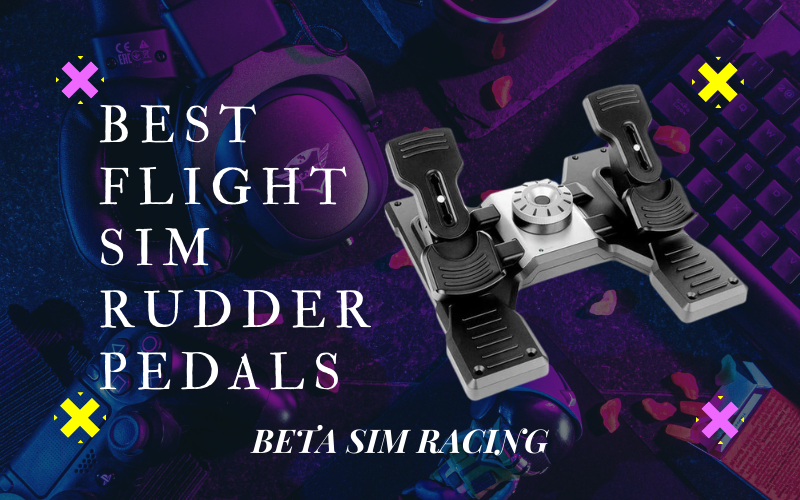
| Feature | Thrustmaster TPR | Thrustmaster TFRP | Logitech G Pro Flight | CH Products Pro Pedals |
| Price Category | High-End | Entry-Level | Mid-Range | Mid-Range |
| Primary Material | All-Metal | Plastic | Plastic / Metal Footplates | High-Strength Plastic |
| Sensor Type | H.E.A.R.T. (Hall Effect) | Potentiometer | Potentiometer | Potentiometer |
| Movement Mechanism | PENDUL_R (Suspended) | S.M.A.R.T. (Sliding Rail) | Sliding Rail | Sliding Rail |
| Braking System | Independent Differential | Independent Differential | Independent Differential | Independent Differential |
| Tension Adjust | Yes (Springs) | No | Yes (Rotary Dial) | No |
| Pedal Angle Adjust | Yes (5 Positions) | No (Heel Rests Removable) | No | No |
| Platform Comp. | PC | PC, Xbox*, PS* | PC | PC, Mac |
| Connectivity | USB | USB, RJ12 | USB | USB |
| Weight | ~7 kg (15.4 lbs) | ~2.2 kg (4.8 lbs) | ~2.3 kg (5.1 lbs) | ~1.7 kg (3.7 lbs) |
| Ideal User | Hardcore Enthusiasts | Beginners / Budget-Conscious | Intermediate Sim Pilots | All-Purpose Users |
*Console compatibility for the Thrustmaster TFRP is achieved when connected via a compatible Thrustmaster throttle/yoke, not directly to the console.
Understanding the Core Components of Flight Sim Pedals
To properly evaluate flight simulator hardware, it’s essential to understand the technology that drives it. These core features are what differentiate one model from another in terms of performance, feel, and longevity.
Sensor Technology: Potentiometers vs. Hall Effect
The sensor is the heart of any rudder pedal set, translating your physical input into a digital signal.
- Potentiometers: This is a more traditional sensor that relies on a physical wiper moving across a resistive track. While cost-effective and reliable for general use, the physical contact can lead to wear over time, potentially causing signal noise or “spiking” that affects precision.
- H.E.A.R.T. (HallEffect AccuRate Technology): Used in high-end Thrustmaster products, this system employs magnetic sensors. There are no physical contacts, which means virtually no wear and tear. This results in superior, sustained precision throughout the product’s lifespan. The resolution is also typically much higher, allowing for finer control inputs.
Build Materials and Construction
The materials used directly impact the stability, durability, and feel of the pedals.
- Plastic: Common in entry-level and mid-range pedals, modern high-strength polymers can be quite durable. However, plastic construction can sometimes lead to flex under heavy use and a lighter overall weight, which may cause the unit to slide on the floor if not secured.
- Metal: Found in high-end models, all-metal construction provides maximum stability and durability. The significant weight prevents slipping and provides a more authentic, robust feel, crucial for a dedicated sim racing cockpit.
Movement Mechanism: Sliding vs. Pendular
The way the pedals move dictates their ergonomic feel.
- Sliding Rail: This is the most common design, where the pedals slide forward and backward on a set of rails. It’s an effective and space-efficient system found on most pedals from entry-level to mid-range. Thrustmaster uses the branding S.M.A.R.T. (Sliding Motion Advanced Rail Track) for their system.
- Pendular: This mechanism, found on the Thrustmaster TPR, suspends the pedals from above. This mimics the ergonomics of many real aircraft, promoting a more natural ankle and foot motion. It is a more complex and expensive design but is often favored by serious enthusiasts for its realism.
Adjustability and Ergonomics
The ability to customize the pedals to your body and preferences is key for comfort during long flight sessions. Key adjustments include tension control, which dictates how much force is needed to move the pedals, and pedal angle/position, which allows you to change the resting angle or width of the footplates.
Expert Insight: A stable, well-configured set of rudder pedals is a cornerstone of an immersive simulation experience. Much like how a direct drive wheel transforms a racing game, quality rudder pedals fundamentally change your interaction with a flight simulator, enabling techniques that are impossible with simpler controls.
In-Depth Analysis of Current Flight Sim Rudder Pedals
Here we provide a detailed, objective breakdown of each product’s features and characteristics based on specifications and performance data.
Thrustmaster Pendular Rudder (TPR)
The Thrustmaster TPR represents the high-end tier of consumer flight simulation hardware. It is designed for serious enthusiasts who prioritize realism and build quality above all else.
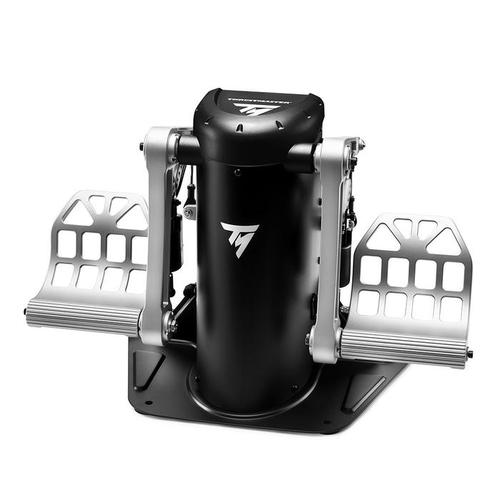
Key Specifications
- Material: 100% Metal
- Sensor: H.E.A.R.T. 3D Hall Effect sensors
- Resolution: 16-bit
- Mechanism: Suspended PENDUL_R system
- Adjustability: 2 adjustable springs (tension), 5 pedal angle positions
- Compatibility: PC
Detailed Breakdown
The TPR’s all-metal construction gives it a substantial weight of 7 kg, ensuring it remains completely stable during use. Its defining feature is the PENDUL_R mechanism, which provides a suspended, pendular motion that is both smooth and ergonomically superior for many users compared to sliding designs.
Internally, the H.E.A.R.T. magnetic sensors deliver exceptionally high precision and eliminate the potential for wear over time. This technology is a significant step up from the potentiometers found in lower-priced models. Adjustability is also a key strength; users can alter the resistance by changing the two provided springs and can set the pedals to one of five different angles to suit their comfort.
Objective Summary
The Thrustmaster TPR is an investment in precision and realism. Its industrial-grade build and advanced sensor technology are engineered for longevity and accuracy. It is ideally suited for dedicated flight sim enthusiasts who have a permanent or semi-permanent setup and demand the highest fidelity in their control inputs. Its price point and size make it less practical for casual users or those with limited space.
Thrustmaster TFRP (T.Flight Rudder Pedals)
The Thrustmaster TFRP is positioned as an accessible entry point into dedicated yaw and brake control, making it a popular choice for beginners and those on a tighter budget.
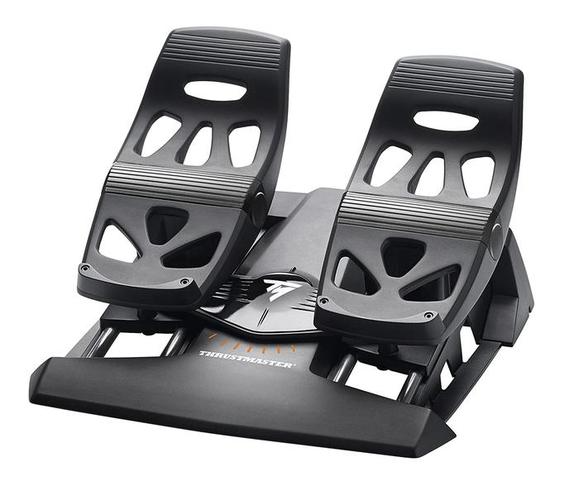
Key Specifications
- Material: Plastic
- Sensor: Potentiometer
- Mechanism: S.M.A.R.T. (Sliding Motion Advanced Rail Track)
- Braking: 10-inch (25 cm) differential brake pedals
- Compatibility: PC; Xbox & PlayStation (via compatible Thrustmaster peripherals)
Detailed Breakdown
The TFRP utilizes Thrustmaster’s S.M.A.R.T. sliding rail system, designed to provide a smoother motion than basic rail designs. The entire unit is constructed from plastic, which keeps the cost and weight down. While this makes it less robust than premium models, it is sufficient for standard use.
A notable feature is its large differential brake pedals, which offer comfortable and effective braking control. For console players, the TFRP offers a key advantage: it can connect via an RJ12 cable to compatible Thrustmaster yokes and throttles (like the T.Flight HOTAS), enabling use on Xbox and PlayStation systems. For those interested in Thrustmaster’s ecosystem, checking reviews of other products like the Thrustmaster T300RS can provide a broader understanding of their product philosophy.
Objective Summary
The Thrustmaster TFRP serves its purpose as a functional, budget-friendly set of rudder pedals. It provides the essential functions of yaw and differential braking, representing a significant upgrade over a twist-grip joystick. Its primary limitations are the plastic construction and potentiometer-based sensors, which are typical for its price point. It is an excellent choice for new pilots or anyone looking to complete their first sim racing setup without a large initial investment.
Logitech G Pro Flight Rudder Pedals
As the successor to the well-regarded Saitek product line, the Logitech G Pro Flight Rudder Pedals occupy the mid-range, balancing features, performance, and cost.
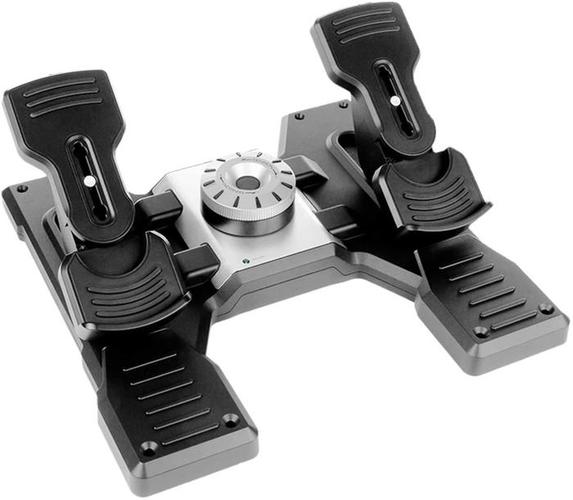
Key Specifications
- Material: Plastic with metal footplate accents
- Sensor: Potentiometer
- Mechanism: Self-centering sliding rail
- Adjustability: Adjustable tension dial
- Compatibility: PC
Detailed Breakdown
These pedals offer a fluid, self-centering rudder axis and independent toe brakes. A key feature is the adjustable tension dial, which allows users to customize the amount of resistance required for rudder input without needing to swap springs or components. This makes it easy to dial in a preferred feel on the fly.
The construction is primarily durable plastic, though the pedals themselves have a solid feel. While they use potentiometers, the design has proven to be reliable for thousands of users over many years. For PC simmers looking for a straightforward, plug-and-play experience with more customization than entry-level models, this product is a very popular choice. Those familiar with other Logitech products like the Logitech G920 will find a similar focus on user-friendly design and functionality.
Objective Summary
The Logitech G Pro Flight Rudder Pedals are a reliable workhorse for the mainstream flight simulation community. They offer a significant step up in feel and functionality from entry-level gear, with the tension dial being a major convenience. While they lack the premium materials and advanced sensors of high-end models, they provide excellent performance and adjustability for their price, making them suitable for a wide range of intermediate users.
Logitech Pro Flight Rudder Pedals (Legacy Information)
It is important for users searching for this product to understand its history to ensure they are getting accurate, current-day information.

A Note on Branding and Availability
The ” Logitech G Pro Flight Rudder Pedals” were a long-standing benchmark in the flight simulation community. In 2016, the Saitek brand and its product lines were acquired by Logitech.
Following the acquisition, the product was rebranded and is now sold as the Logitech G Pro Flight Rudder Pedals. The core design and functionality remain the same. Therefore, any search for a new “Saitek” branded pedal set will lead to the current Logitech model. Information or reviews pre-dating the Logitech acquisition refer to the same fundamental hardware. Users should refer to the Logitech G Pro Flight Rudder Pedals section above for the most current details.
CH Products Pro Pedals USB
CH Products has a long-standing reputation for producing durable, no-frills simulation hardware, and the Pro Pedals are a testament to that philosophy. They have remained a consistent presence in the market for years.
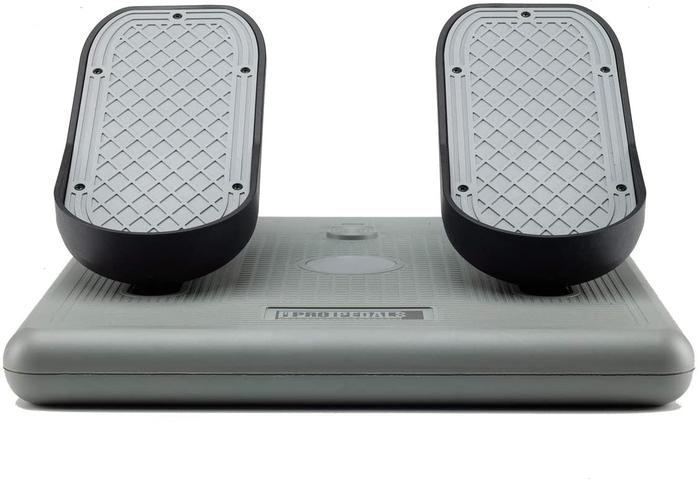
Key Specifications
- Material: High-strength, durable plastic
- Sensor: Potentiometer
- Mechanism: Sliding rail
- Axes: 3 (Rudder, Left Toe Brake, Right Toe Brake)
- Compatibility: PC, Mac OS
Detailed Breakdown
The CH Products Pro Pedals are known for their exceptional durability and long lifespan, a common trait across the CH product ecosystem. The design is straightforward: a forward-and-back sliding motion for yaw and pivoting toe brakes. The pedal base is wide, providing good stability during use.
While they lack features like tension adjustment, their strength lies in their reliability. They are truly plug-and-play on both PC and Mac systems and are often praised for their smooth and accurate axes, which hold their calibration well over time. The simplistic, robust design makes them a favorite in both home cockpits and more demanding educational or training environments.
Objective Summary
The CH Products Pro Pedals are an excellent choice for users who value durability and reliability over advanced features and modern aesthetics. Their industrial design may appear dated to some, but their performance is time-tested. They are particularly well-suited for flight sim users who want a product that will work without fuss for many years. Their simplicity and robustness make them a solid investment for any intermediate pilot.
Frequently Asked Questions (FAQ)
Are rudder pedals necessary for a flight simulator?
While not strictly necessary to start (many joysticks have a twist axis for rudder control), they are essential for realistic flight. They allow for precise taxiing, coordinated turns, and proper handling in crosswinds, making them one of the most significant immersion upgrades you can make.
What is the main difference between rudder pedals and car racing pedals?
Flight rudder pedals operate on a sliding axis for yaw control (turning the plane’s nose left and right) and have individual toe brakes. Racing pedals, such as those reviewed in a Logitech G29 review, feature separate pedals for throttle, brake, and clutch that depress inwards and do not have a sliding yaw axis. They are not interchangeable.
Can you use flight sim rudder pedals for racing games?
While technically possible with software remapping, it is not ideal. The sliding axis and toe brakes do not translate well to the inputs needed for accelerating and braking in a car. It is better to use hardware designed specifically for each simulation type.
What are differential brakes?
Differential braking allows you to apply the brake on the left and right wheels independently by pressing down on the top of the left or right pedal. This is crucial for steering the aircraft on the ground at low speeds and for making tight turns.
How do you stop rudder pedals from sliding on the floor?
This is a common issue, especially with lighter, plastic models. Solutions include placing them on a high-friction mat (like a carpet or rubber mat), bracing them against a wall, or mounting them to a dedicated racing wheel stand or cockpit.

Isabella is our resident expert on all things simulation, from intricate management sims to relaxing life sims. Her features and guides celebrate the joy of creation and optimization that defines the genre. She has a talent for finding the compelling gameplay loops in even the most niche simulation titles.
